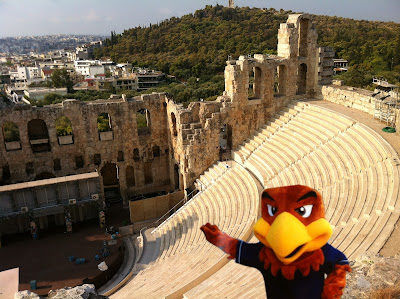After leaving Greece, Flat Hawkster's next stop was Barcelona, Spain. Check out the short video below that was taken just after his flight left the Mykonos, Greece airport.
Barcelona is the second largest city in Spain (to Madrid) with a population of 5 million people living in the metropolitan area. Barcelona's airport is one of the busiest in Europe with over 34 million "flyers" each year. That is a lot of baggage! Flat Hawkster arrived at night which made things a little more challenging. He ended up on the wrong train for a while before wandering around and eventually finding a place to rest. When he awoke the daylight introduced him to a beautiful city that is alive with festivals, beaches, outdoor restaurants and music. He has really enjoyed learning about Barcelona and taking part in some of the fun.
 |
| This was one of the streets playing host to a local music festival. |
Flat Hawkster spent his first day in Barcelona visiting a number of buildings designed by the famous Spanish architect named Antoni Gaudi. He lived until 1926 and became famous for the modernist style of architecture that he used. His most famous work is the Sagrada Familia (seen below) which be began working on during the 1880's. By the time he died in 1926 it was only 25% complete and is still not yet done! Intermediate students may want to mention Gaudi the next time they are late with a project:)
 |
| This is the Sagrada Familia that is still a work in progress but that doesn't stop thousands of tourists from visiting each day to tour inside. |
Barcelona provides a lot of things for people to do and one of the most popular experiences is having a beach day. Flat Hawkster put on plenty of sunscreen and spent a lot of time walking along the beaches that seemed to run forever. He saw many things as he walked: beach rugby, volleyball, helicopters, modern buildings, restaurants, performers, yachts and so much more. It was a busy place but provided a refreshing breeze to cool him off on a very hot day.
 |
| Volleyball and ping-pong (below) were just two of the many activities available for visitors to the beach. Unfortunately every time Flat Hawkster plays ping pong his talons ruin the paddles. |
As some of you may know, Spain is the top-ranked country in the world when it comes to soccer (Football). The sport is very popular in this nation and this was made clear to Flat Hawkster when he saw a lot of children just dribbling a soccer ball down the street as their parents shopped. There were also thousands of Barcelona FC banners/flags hanging from apartments all over the city, showing support for their local team which happens to be, arguably, the best team in the world. On top of that, one of the players on Barcelona FC (Lionel Messi) is considered my most people to be the best player in the world. With all of this in mind, Flat Hawkster had to go to one of the team's games and join 110,000 other fans supporting the local team. It was crazy!
In the brief clip below you can hear the local supporters singing along as they celebrate a late victory by their home team. Lionel Messi also scored which sent almost everyone home happy.





































